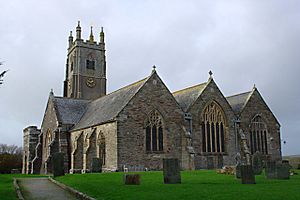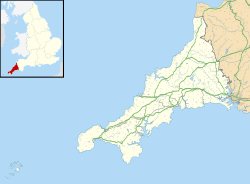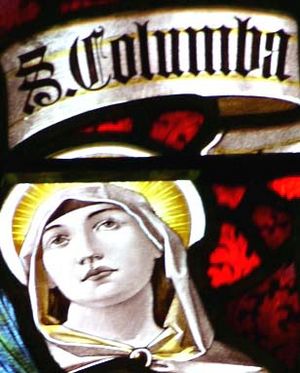St Columba's Church, St Columb Major facts for kids
Quick facts for kids Church of Saint Columba |
|
|---|---|
 |
|
| 50°26′08.5″N 04°56′25.1″W / 50.435694°N 4.940306°W | |
| OS grid reference | SW 91297 63675 |
| Location | St Columb Major |
| Country | England |
| Denomination | Church of England |
| Website | Lannpydar.org.uk |
| History | |
| Dedication | Saint Columba the Virgin |
| Specifications | |
| Spire height | 80 feet (24 m) |
| Materials | Slatestone rubble with granite dressings |
| Bells | 8 |
| Administration | |
| Parish | St Columb Major |
| Deanery | Pydar |
| Diocese | Truro |
| Province | Canterbury |
The Church of Saint Columba is a very old and important church located in St Columb Major, Cornwall, England. It was mostly built in the 14th century. This church is part of the Church of England and is dedicated to Saint Columba the Virgin.
It is a Grade I listed building, which means it's considered a very special historic place. In the 1860s, there were plans for this church to become the main cathedral for Cornwall. However, the actual cathedral was built in Truro instead. There is another church nearby, St Columba's Church, St Columb Minor, also named after the same saint.
Contents
History of the Church
The church building you see today was constructed over several centuries, mainly between the 13th and 15th centuries. Inside, you'll find a very old Norman font, which is a basin used for baptisms. There are also amazing wooden carvings, like the bench ends from 1510, a special screen called a rood screen, and unique wagon-shaped roofs. The wooden pulpit, where sermons are given, was carved in the 1800s.
In 1676, something very sad happened. Three young people accidentally caused a fire with gunpowder, which damaged the church. The repairs cost about £350 at the time. But with help from public donations and a small local tax, the church was fixed up in just nine months!
Church Community
This church is part of a group of churches called the Lann Pydar joint benefice. This group includes:
- St Ervan Church
- St Eval Church
- St Mawgan Church
Church Organ
The church has a beautiful organ that was built in 1870. It was made by a company called Bryceson & Ellis from Lincoln. You can find more details about this organ in the National Pipe Organ Register.
The Font
The font is a large stone basin used for baptisms. The one in St Columba's Church is octagonal (eight-sided) and is located in the south aisle. It dates back to around 1300. It has carved sides, including five faces of men, and stands on a stem with smaller columns around it.
Church Bells
The church has eight bells! They were made at different times, from 1776 to 1950. The oldest bells were made by J C & W Pennington of Exeter in 1776. Later bells were made by John Taylor & Co in 1950 and 1969. One bell from 1825 was made by John Rudhall. In 1950, the bells were checked and repaired by the Loughborough Bellfoundry. The heaviest bell, called the tenor, weighs about 637 kilograms (1404 pounds).
Important Memorials
Inside the church, there are some interesting monumental brasses and memorials. These are special plaques or carvings that remember important people. Some of these include:
- Sir John Arundell (1474–1545), who was a very important person in Cornwall. His brass memorial is considered one of the most detailed in the area.
- Eleanor Grey, who was Sir John Arundell's wife. She was also the granddaughter of Elizabeth Woodville, who was the Queen of England and married to King Edward IV.
- Sir John Arundell, who passed away in 1591, and his wife (who passed away in 1602). Their brass was engraved in 1635.
- John Arundell and his wife, from 1633, are remembered on the same stone.
- Robert Hoblyn, who was a Member of Parliament for Bristol. He passed away in 1756. His memorial in the church has a long inscription.
- Sir Richard Bellings (1622 – 1716) was an Irish courtier. He worked as the Knight Secretary for Catherine of Braganza, who was the wife of King Charles II.
War Memorial
Outside the church, there is a granite war memorial. It was put up in 1920 and looks like a traditional Cornish cross. This memorial lists the names of 55 men connected to the parish who lost their lives in the First and Second World Wars.
Other Interesting Features
The church has a beautiful wooden screen designed by the architect George Fellowes Prynne. There are also some amazing oak bench ends that date back to 1510. The fine organ was made by Bryceston Bros. & Ellis of London. You can also see a copy of the "Letter of Thanks" that King Charles I sent to the people of Cornwall in 1643. Many churches in Cornwall have copies of this letter.
There are also two sculptures by the artist Allan G. Wyon and a colorful stained glass window that shows Saint Columba the Virgin. In the churchyard, you can find St Columba's Cross.



